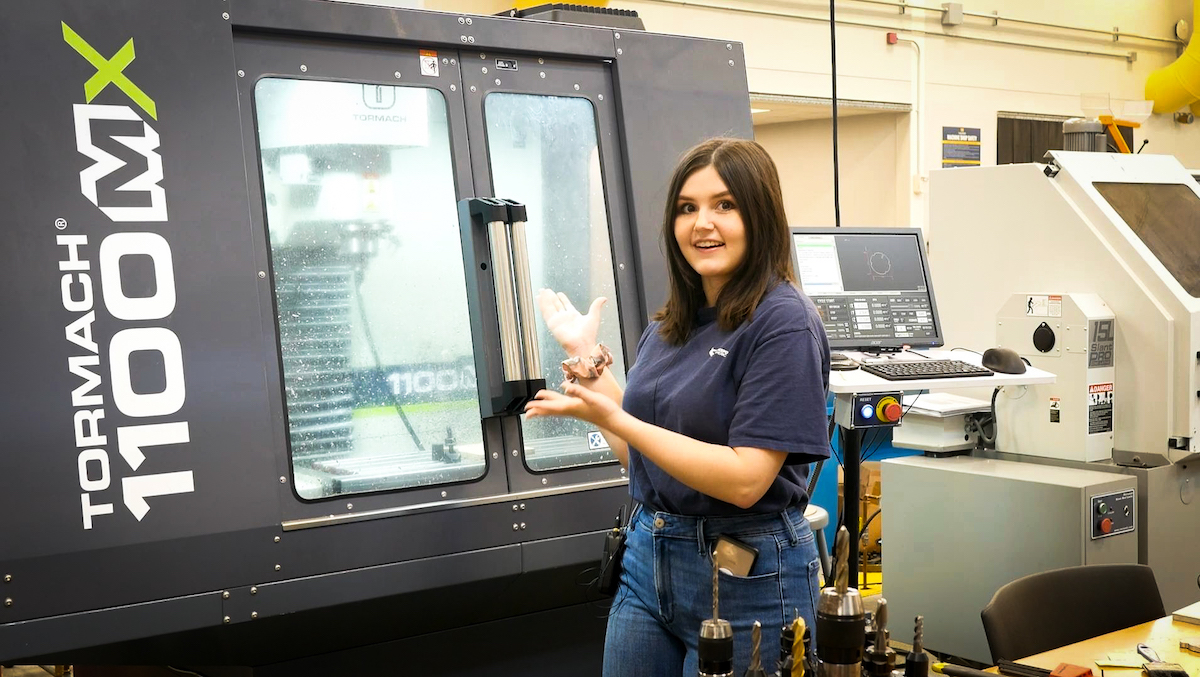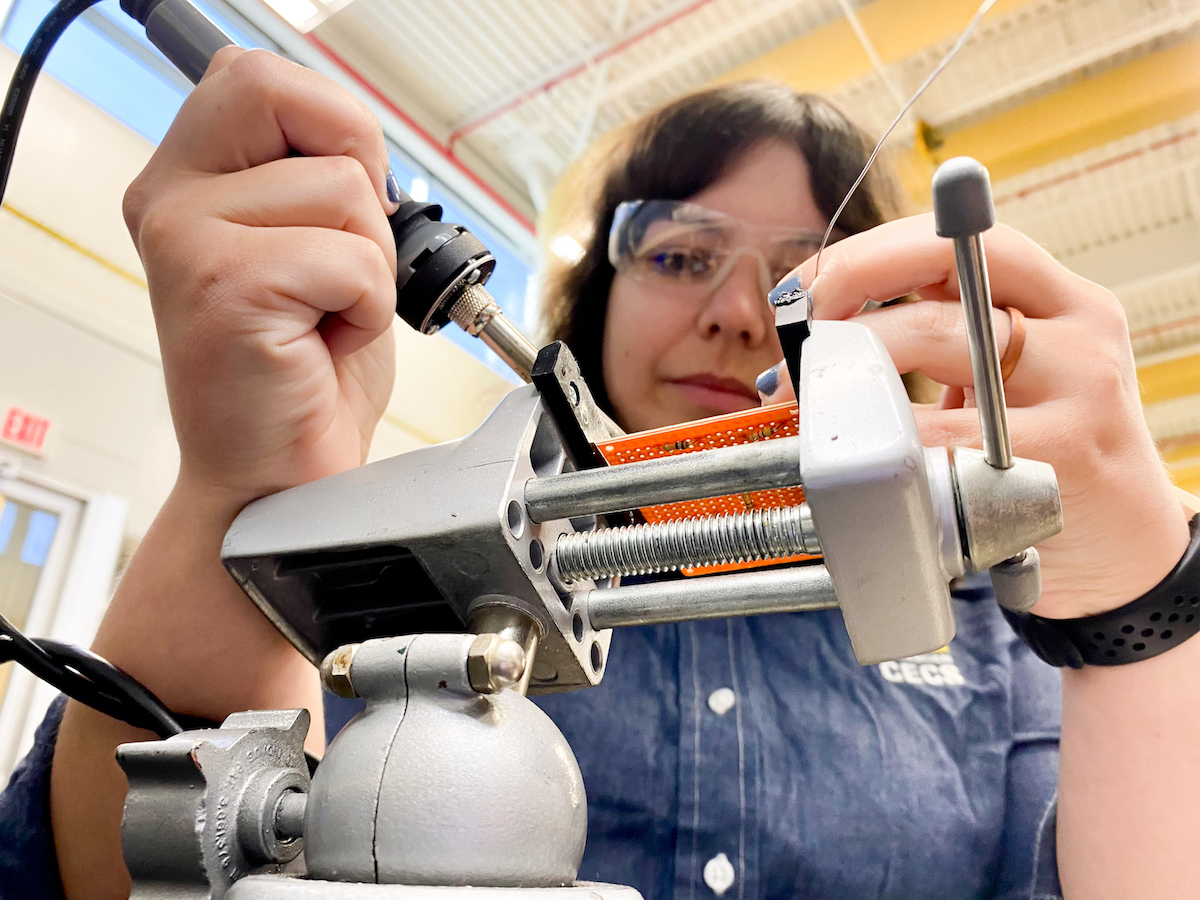
We've been giving UM-Dearborn's new Engineering Lab Building a lot of love over the past two years, for good and obvious reasons. It’s a stellar piece of architecture that boasts 45 labs, tens of millions of dollars worth of advanced equipment, and dozens of collaboration spaces. Students and faculty are loving it so far. But if you talk frequently with our engineering folks, you'll hear lots of stories about how the path to becoming an engineer who’s a cut above often runs through a lesser known building. Given its more ordinary architectural shell, we’ll forgive you if you’ve never actually noticed, let alone been inside, the Manufacturing Systems Engineering Lab. But what’s happening inside the MSEL on any given day tends to be anything but ordinary. Walk in and you’ll immediately see “The HAAS,” an epic 4-axis CNC mill that one student told us “looks like something astronauts train in.” A whole roster of 3D printers will probably be churning. And there are tools for cutting things with lasers, and tools for working on electrical circuitry. Of course, there’s also a full slate of tools for building things out of wood, which MSEL Assistant Director Shawn Simone says may be an old-school material, but because it’s cheap and forgiving, is great for learning how to make stuff. In particular, he’s super psyched about the new CNC-guided wood router they’re setting up that he says is bound to become everyone’s new favorite machine.
Getting your hands dirty in the MSEL, whether it’s as part of a class or one of the student engineering teams, has become something of a rite of passage for many UM-Dearborn engineering students. It’s here where many of the abstract concepts and equations they’ve been studying in their physics and calculus courses actually become real. Simone says the “a ha moments” are usually easy to spot. "Just last week, I had this kid hand me a print for a manufactured part, and I said, 'I’m sorry buddy, but I can’t do this,'" Simone says. "'The way the print is laid out with your dimensioning and the way tolerances stack, there is just no way you are going to be able to build this design and get the results you want.' So I explained that, and we talked about some changes, and he got this look on his face and said, ‘Oh….so that’s what the professor meant.’ These students learn and retain an incredible amount of information, but it’s often not until they come down to the MSEL that the rubber hits the road. Working with us, I guarantee your classes are going to make more sense."
Mechanical engineering senior Sierra Stockwell can testify to the MSEL’s transformational powers. In high school, she says she was an “artsy, theater kid,” whose experience with tools consisted of “using a drill maybe three times.” Now, after putting in countless hours at the MSEL, primarily through her role with MASA, the UM-Dearborn rocket club, she welds, mills, drills, saws, cuts, 3D prints and is one of a handful of people on campus who are allowed to use some of the lab’s most advanced tools. As the MSEL’s student manufacturing technician, she even teaches some of the classes on how to use the equipment. One of the things she observes about beginning engineering students is that they’re really focused on design. But until you understand how those CAD files get turned into real physical things, it’s super easy to make obvious mistakes. “You learn the most when you give yourself a headache because you’ve put an allen wrench connection in a place where it’s impossible to turn an allen wrench,” Stockwell says. But those “mistakes” typically lead to revisions that force simpler, better designs. Not only that, you bank that knowledge for the future: Learning how manufacturing processes work gives you a leg up next time you design something, because you’re able to anticipate problems. “You start off thinking about the designing and building as two separate things, but it’s all part of the same messy, nonlinear process,” she says.

Experience in the MSEL often has huge payoffs for students. Some of our most involved MSEL alum have gone on to work at SpaceX, Raytheon and NASA, and Stockwell herself is now interning as an engineering technician at Quantum Signal AI, where she works in the machine shop on autonomous vehicle projects. Beyond impressing employers, Electronic Engineering Technician Monica Somand says MSEL experience can have huge practical benefits once you hit the workplace, namely because your fluency in manufacturing processes becomes a bridge between the design and build teams. “I used to work at the Ford dynamometer lab, working with many technicians and engineers. And I have noticed in industry that the best engineers to work with were the ones who knew how to work in the physical realm,” Somand says. “They were the ones who could talk with the technicians or the fabricators in the shop and work through a problem. I think that’s one of those intangibles that students walk out with because of their experiences in the MSEL.”

UM-Dearborn engineering lecturer Kas Kasravi is big on the MSEL’s intangibles too. An industry veteran from Hewlett Packard, he often books large blocks of time for his students to experience the “extremely well-equipped lab,” so they can learn something you can’t really teach. “You can’t really teach someone how to be creative or innovative — you actually have to be creative,” he says. “When a student puts together a circuit or 3D prints some parts and puts them together to make something that actually works, you can often see something happen in their eyes or in the big smile that comes across their face. It’s a representation of something clicking. They see that by reasoning through a problem, you can create something useful. That’s a mindset they can apply no matter what career they choose.”
Interestingly, the MSEL isn’t just for engineering students. With an unofficial motto of “Build stuff, be cool,” Simone says the lab was envisioned as a maker space for anyone in the UM-Dearborn community, and all faculty, students and staff can come in and make whatever they want. (You just have to supply your own materials.) Simone says one member of the engineering administrative staff is already busy making Christmas ornaments. Somand says last semester, a hardcore Harry Potter fan was putting in some long hours making replicas of all the different wands from the movies. And Stockwell seriously admired the dedication of the person who made their own Ironman mask for a cosplay event, rather than buying one off the shelf. Even better, an increasing number of faculty are enrolling in the MSEL’s lineup of shop classes so they can utilize that knowledge in their courses. Honestly, Simone and Somand wish more folks took advantage. “When you walk in and you see five, six, seven people already working, it just gives you this energy, and that’s when the cross-pollination happens,” Simone says. “In a full shop, there’s no stopping the creativity.”
###
Have a project you need some help with? Or just want to up your shop skills? Give Simone or Somand a shout to learn more about the classes you can take at the MSEL. Story by Lou Blouin.




